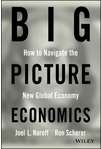 Big Picture Economics
Big Picture Economics
How to Navigate the New Global Economy
By Joel L. Naroff and Ron Scherer
234 pages
John Wiley & Sons
Joel L. Naroff is a distinguished economist, the president and founder of Naroff Economic Advisers, a consultancy, twice recognized by the National Association for Business Economics as NABE’s top economic forecaster (2007 and 2011).
For this book he has teamed up with Ron Scherer, a journalist who covered economics at The Christian Science Monitor for 37 years, retiring last summer.
They wrote this book to make one simple point: that the phrase “it depends” expresses the most important economic idea of all. Context can make a perfectly logical forecast utterly wrong, and it can make two similar-sounding actions work out very differently.
An abstract idea like that can make for a great book, or for a boring one. It depends … on how the idea is applied. In this case, I have to appraise the results as somewhere in between “great” and “boring.” A phrase like “fascinating in spots” will serve.
Malthus and Context
Naroff and Scherer apply their context-is-all Big Picture to Malthusian population theory, for example. [This particular vortex of controversy is familiar to regular readers of AllAboutAlpha.] They describe Thomas Malthus (1798) as the man who predicted that “population would inevitably outpace food production, and that would lead to starvation.” They then contend that this outpacing has proven to be something less than inevitable, because the production of food depends upon ever-changing technological factors. This was true even in Malthus’ own time, when farmers were experimenting with new systems of crop rotation. Technological factors became much more important a century or so after Malthus’ death, around the time mechanical devices were replacing teams of oxen as the way to move a plow.
But, Naroff and Scherer continue, this doesn’t mean Malthus was “totally wrong.” He is right in certain quite specific contexts. There are, even today, countries and regions where “the ability to bring new farm land into productive use” is limited and where it is overwhelmed by birth rates and the consequent increase in the demand for food.
The Middle Class
Another question these authors address, in a widely separated part of the book but in a way not utterly unrelated from the treatment of Malthus in a logical sense, is this: is the middle class doomed? Will globalization and related 21st century trends end in a nightmarish polarization of rich and poor worldwide? They don’t join in with the doomsday prophets here either.
Yes, the United States in particular has experienced a “winnowing out of the middle class” in recent decades. This was in part a consequence of the creation of global supply chains, so that workers creating the goods sold to Americans “could be anywhere.” In part, too, the winnowing has come about because many middle management jobs that used to fill up the ranks of the middle class no longer exist. The movie isn’t going to run in reverse, and the U.S. “will have to restructure its economy to take into account” the underlying facts.
In short, Americans have to get used to a smaller middle class than we would like.
But no, it does not follow that the middle class will disappear, here or worldwide. One part of the relevant context, on this issue, is that the trend of outsourcing manufacturing work from the U.S. to China or other Asian nations may be nearing its culmination. Wages are rising in China in particular, and with that rise, the cost advantage that drew manufacturers to China in the first place is shrinking.
“In the 1990s,” Naroff and Scherer write, “no CFO or CEO could get fired for deciding to move production to China….But if a company made the same decision two years ago, they may have found that the cost structure has changed dramatically enough to make the assessment questionable.”
For a time, these authors’ focus on the bilateral relationship between the U.S. and China reminds me of Zachary Karabell’s book of a few years back, Superfusion, in which Karabell argued explicitly that the two economies were becoming one, and that “the world’s prosperity depends on it.”
So: what is the big picture? Are China and the U.S. trading places, so that China will have a middle class and the U.S. won’t? No. What is happening is a bit more subtle than that. The U.S. may well learn that it can successfully export goods to China, selling to their middle class and preserving much of its own in the process.
Naroff and Scherer expect that the Chinese currency will appreciate vis-à-vis the dollar, which will give U.S. exporters a comparative advantage, and help this merger of the two economies forward.
One More Thing
When I first outlined this review, I planned to summarize here the Naroff/Scherer take on fracking as well. This review is running long, though, so I’ll keep this very short. You might well wonder if hydraulic fracturing will turn out to be a good thing for the U.S., and for that matter for the industrialized world and the planet?
It depends.



